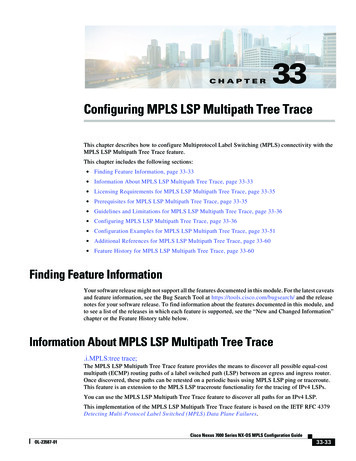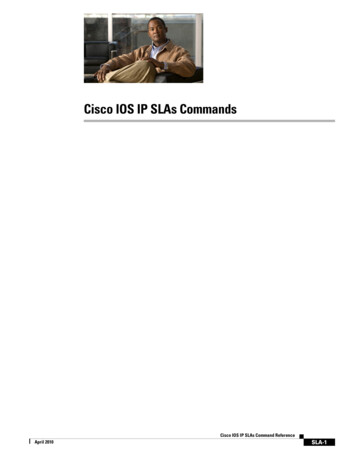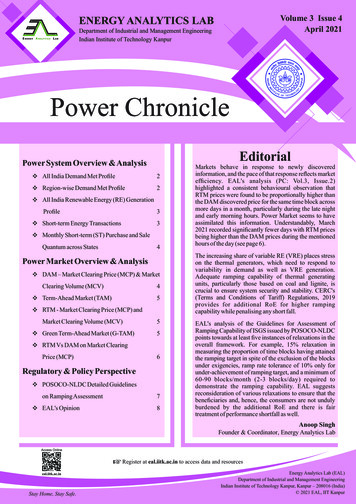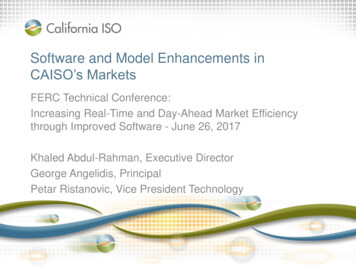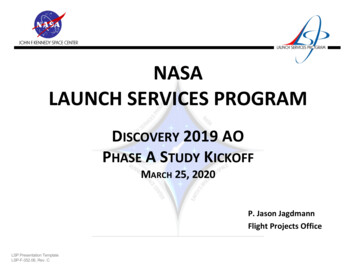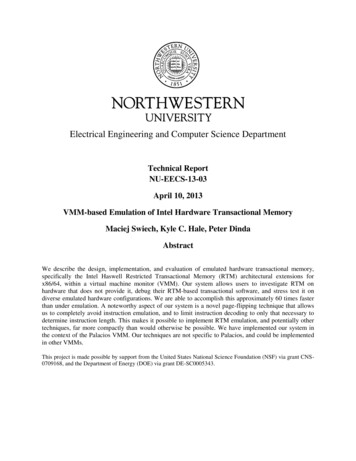
Transcription
SIGMA Assessment SystemsTalent DevelopmentUsing the LSP-R toDevelop Large Groupson a Small BudgetTM 2022 SIGMA Assessment Systems, Inc. All rights reserved.
Using the LSP-RTM to Develop Large Groups on a SmallBudget“The growth and development of people is the highest calling of leadership.”- Harvey S. Firestone, Founder Firestone Tire and Rubber CompanyMost organizations understand the importance of talent development. And yet, more often than not,leaders struggle to take time to invest in their employees. Budgets are another barrier. Very fewcompanies are willing (or able) to set aside the financial resources required to build a robust talentdevelopment process from scratch. Most also don’t have staff who would be equipped and available todo so. What’s the solution? How can organizations make talent development a priority withoutsacrificing too much of their budget or human resources to do so?SIGMA can help. In this guide we will walk you through how you can develop large groups on a smallbudget. The key lies in using a robust leadership assessment and guiding your team through astandardized development process. We’ll show you how you can do both using SIGMA’s LeadershipSkills Profile – Revised (LSP-R).The Benefit of Talent AssessmentsIf you are developing large groups on a small budget, talent assessments are your friend. The primarybenefit of assessments is that they provide structure and standardization to the development process.Countless studies have demonstrated the particular benefit this can have for talent development. TheSociety for Human Resource Management (SHRM) found that careful talent assessment results insignificant productivity increases, cost savings and decreased attrition.1 Online assessments in particular,have become an industry standard, because they reduce costs and decrease the time needed forcompanies to identify, select, and develop talent.2 Another key benefit of using talent assessments isthat it adds objectivity to the process. This helps reduce the impact of personal bias, thereby improvingthe equity, inclusivity, and diversity of their workplace. Finally, since assessments use a standard format,they can easily be scaled across departments or teams. All this makes assessments particularly helpfulfor leaders who are trying to develop large groups on a small budget.Using assessments certainly benefits the talent development process, there are also direct benefits thatSIGMA has observed time and time again for both employees and their organizations:2Your Future. Down to A Science. www.SigmaAssessmentSystems.comDeveloping Large Groups on a Small Budget LSP-RTM
Figure 1. Using assessments for talent development has benefits for employees AND businessesBut what makes the LSP-R different? There are a few things that make the LSP-R unique from otherleadership assessments. First, the LSP-R assessment is psychometrically sound. It was developed byindustrial-organizational (IO) psychologists and validated time and time again in the field. For over 50years, the LSP-R has proven itself to be a reliable tool for clients of all sizes across North America.Second, the LSP-R comes with a Focus Report that guides employees through their results and includestools and activities for creating a personalized development plan (see a sample Focus Report). Finally,the LSP-R can be easily administered online, in 25 minutes, and participants automatically receive theirreport upon completion. This makes the LSP-R a powerful AND practical tool for facilitating talentdevelopment, and it can easily be administered and scaled across teams and organizations. Perfect fordeveloping large groups on a small budget.Getting a Group Through the LSP-RAre you ready to use the LSP-R with your team? We can help you get it done. Here are five simple stepsyou can follow to successfully get a group of employees through the LSP-R.1. Get your assessments. Ordering the LSP-R is a quick and easy process. First, you will have tocomplete an application form to get approval for your online account. Once approved, you willreceive an email with your login information. From there, you may log in, purchase the test, andbegin administration.2. Start by familiarizing yourself with the LSP-R and the Focus Report; you can try the LSP-R forFREE yourself, or review a sample Focus Report.3. Introduce the LSP-R to your employeesa. Use an existing meeting, set a new one, or send your team an emailb. Briefly outline what the LSP-R is and why your company has decided to use it3Your Future. Down to A Science. www.SigmaAssessmentSystems.comDeveloping Large Groups on a Small Budget LSP-RTM
c. Explain to employees that they will receive a link to take the LSP-R, and should do sobefore your next meeting (set a date and time)d. Remind employees to bring their Focus Report to your next meeting and explain thatyou will be reviewing results and guiding them in creating their own development plan4. Send all employees an email with the link to take the LSP-R (you will receive this link when youpurchase the assessment).5. Send all employees a calendar invites for the group debrief. Remind everyone that they musthave the LSP-R completed beforehand, and that they should bring a copy of their Focus Reportto the meeting. We recommend giving employees at least one week to complete the LSP-R.Facilitating a Group DebriefOnce all employees have completed the LSP-R, you are ready to hold your group debrief (feel free tosend a reminder email one or two days before the meeting to ensure everyone has completed theirassessment). At the meeting, guide your employees through their Focus Report using the steps below.You may also download SIGMA’s administrator’s guide, which includes a set of PowerPoint slides youcan use to accompany your debrief/presentation.Download the PPT SlidesAgenda: LSP-R Group DebriefReview and Discuss Results (20 min)Focus Activity 1 (20 min)Focus Activity 2 (20 min)Creating an Action Plan (20 min)Next Steps: Outlining the Development Process (10 min)4Your Future. Down to A Science. www.SigmaAssessmentSystems.comDeveloping Large Groups on a Small Budget LSP-RTM
Review and Discuss Results (20 min)1. Turn to pg 3-4. Have employees look at their results, explaining that competencies are rankedfrom highest to lowest. Note that lower scores do not necessarily indicate a lack of ability, butrather highlight areas may not come easily or naturally.2. Ask your team to identify strengths and find their myZONE (highlighted in blue). Explain that thecompetencies shaded in blue are an individual’s most immediate opportunity for development.These are areas where the individual already demonstrates some degree of skill, providing astrong foundation for development. Focusing development efforts on these competencies islikely to result in myZONE competencies becoming strengths in the near future.3. Ask your team (either for discussion or personal reflection), Do these results resonate with you?Is anything surprising to you? Do you notice any patterns or trends? What do these results tellyou about yourself as a leader?Focus Activity 1 (20 min)After employees have had a chance to review and discuss results, turn to the first Focus Activity on page5. This activity is intended to help employees identify their top three development opportunities (my3competencies). Guide employees through this worksheet using the following steps:1. Select myFOCUS competencies. On the left-hand side, under myFOCUS COMPETENCIES, tellemployees to write down the myZONE competencies they would be interested in developing(choose at least five).2. Get input from colleagues. After they’ve selected their myFOCUS competencies, tell youremployees to turn to a neighbor and ask them which competencies they also view as importantfor their job (choose someone they work with on a regular basis). Use the boxes underCOLLEAGUES to mark the competencies that were verified as important.3. Get input from supervisors. This might be difficult to do in-person during your meeting. Instead,write down which competencies you feel are important for every employee’s job beforehand,and distribute the lists during the meeting. Tell people to use the boxes under SUPERVISORS tomark overlap between the competencies they listed and the ones you verified as important.4. Reflect on personal experience. Tell employees to think of past successes and challenges. Whatcompetencies were needed? From which could they benefit in the future? Put a mark besidethese under the column labelled EXPEREINCES.5. Evaluate. Tally up the stars for each competency and mark which three received the most. Put astar beside those three competencies in the final column on the right-hand side under the star.Then, write the competencies in the boxes in the bottom right-hand corner. These are your my3competencies.5Your Future. Down to A Science. www.SigmaAssessmentSystems.comDeveloping Large Groups on a Small Budget LSP-RTM
6. Share. Take a few minutes for employees to share their my3 competencies or ask questions. Ifyou are holding this meeting online, you can use the poll or chat functions to allow participantsto share their results.Focus Activity 2 (20 min)Once everyone has completed Focus Activity 1, turn to Focus Activity 2 on page 6. Explain that thissecond activity is intended to help employees narrow their my3 competencies down to a singlemyFOCUS competency. In the next activity we will create a personalized development plan around thatcompetency.Have employees start Focus Activity 2 by filling in their my3 competencies in the first row of the table(labeled my3 COMPETENCIES). Next, have them indicate the criteria that are met by each competency.Here’s a quick breakdown of what each criterion means: Impact – Impact refers to how relevant a competency is to the strategy and operations of yourteam. Does the competency help you achieve your goals? Your team’s goals? The organization’slong-term strategy? If it does, then it is an impactful competency. Opportunities – Opportunities refers to the chances you will have to develop and use thiscompetency. Are there places where you can demonstrate, practice, or use this new skill? If so,then it is a high-opportunity competency. Support – Support refers to the buy-in you have from colleagues and supervisors for developingthis competency. Support may come in the form of resources and tools, coaching/mentoring,and feedback processes. If you have all these available to you the competency is well supported. Demand – Demand refers to whether there is a need for this competency to be developed. Willit benefit you in your organization? Industry? Profession? If so, then there is demand for thatcompetency.After employees are done scoring each competency, have them add up their scores and write the totalin the boxes at the bottom of each column. Find the competency that scored highest, and write this inthe space below, labelled myFOCUS competency. In the third (and final) activity we will create apersonalized development plan for that myFOCUS competency.Creating an Action Plan (20 min)Congratulations! You’ve reached the final step of your LSP-R group debrief meeting. In this last activityyou will walk your team through how to create a development plan for their myFOCUS competency.Before you start this activity, we recommend you take a 5-minute break. This will give your employees(and you) a chance to grab a drink, go to the washroom, and clear your head before diving into the thirdand final activity.Ready to go? Start by turning to page 7 in the Focus Report and have employees enter their myFOCUScompetency in the top row. Then give a brief overview of the action plan. Employees will brainstorm6Your Future. Down to A Science. www.SigmaAssessmentSystems.comDeveloping Large Groups on a Small Budget LSP-RTM
activities they can STOP, START, and CONTINUE in order to develop their myFOCUS competency. Toillustrate, use the following example:Meet Henry. Henry is a team lead at an automotive manufacturingfirm. He has chosen to work on the leadership competency“Delegation.” To do so, Henry is going to STOP micromanaging (what)by setting a weekly check-in with his direct reports and allowing themto come to you for additional guidance on a per-need basis(how/when). Henry is also going to START looking at his tasks at thebeginning of each week and consider whether someone on his teammay be available and qualified to complete them. If so, Henry is goingto start delegating these tasks (what) individually or at a team meetingat the start of each week (how/when). Finally, Henry is going toCONTINUE organizing deliverables himself (what), because he, as theleader, will still be held accountable for all assignments to his team. Hewill do this by maintaining the checklist of tasks and timelines he hascreated for himself but will also keep track of ownership for the taskshe chooses to delegate (how). Henry will update this list at thebeginning of each week and monitor it throughout (when).As the group fills out their action plan, emphasize the importance of setting SMART goals (specific,measurable, actionable, relevant, timely). In particular, tell people to think of practical ideas and set atimeframe within which they will be accomplished.As the group fills out their action plan, emphasize the importance of setting SMART goals (specific,measurable, actionable, relevant, timely). In particular, tell people to think of practical ideas and set atimeframe within which they will be accomplished.Next Steps: Outlining the Development Process (10 min)Once everyone has finished their development plan, leave some time to discuss the importance ofimplementation. It’s not enough to create action plans. Those plans must also be carried out if you wantto see improvement in your team’s abilities. We’ve created another template for that.Ask the group to turn to page 8 in their Focus Report. This page has a guided reflection activity that canhelp employees identify what they’ve learned and how they are going to apply it as they embark alongthe development process. Encourage employees to set aside half an hour at the end of each month tofill out this template and meet with a manager, supervisor, or mentor. Have them discuss what they arelearning and brainstorm new opportunities for ongoing growth and development together. This personcan act as a coach to your employees, helping them challenge their thoughts and assumptions, and setSMART goals. Often a coach may be able to facilitate job shadowing, stretch assignments, or shareresources your employees may not have otherwise had access too. As a result, studies have shown thatcoaching makes it significantly more likely that candidates will achieve their development goals.3 It alsoincreases the likelihood that this behavior change will remain long-term.4, 57Your Future. Down to A Science. www.SigmaAssessmentSystems.comDeveloping Large Groups on a Small Budget LSP-RTM
Note: If the group you are taking through the LSP-R has no managers, supervisors, or mentors apartfrom you, and you will not be able to coach them all yourself, SIGMA can help! We offer group andindividual coaching sessions and would be happy to support your team as they implement theirdevelopment plans.Looking for More?If you have questions about the LSP-R or your group’s development plans, SIGMA is here for you! Inaddition to our group and individual coaching services, we also offer 1-hour Lunch and Learns. Theseonline sessions are convenient, practical, and engaging. If you’re interested, give us a call or contact usbelow! We would love to hear from you.Contact UsSHRM. (2016). Choosing Effective Talent Assessments to Strengthen Your Organization. SHRM Foundation’sEffective Practice Guideline Series (EPG). Retrieved from tive-talent-assessments.pdf.2Ibid.3Harkin, B., Webb, T. L., Chang, B. P. I., Prestwich, A., Conner, M., Kellar, I., , & Sheeran, P. (2016). Doesmonitoring goal progress promote goal attainment? A meta-analysis of the experimental evidence. PsychologicalBulletin, 142, 198-229.4Baron, L., & Morin, L. (2010). The impact of executive coaching on self-efficacy related to management soft-skills.Leadership & Organization Development Journal, 31, 18-38.5Sonesh, S. C., Coultas, C. W., Lacerenza, C. N., Marlow, S. L., Benishek, L. E., & Salas, E. (2015). The power ofcoaching: A meta-analytic investigation. Coaching: An International Journal of Theory, Research and Practice, 8, 7395.18Your Future. Down to A Science. www.SigmaAssessmentSystems.comDeveloping Large Groups on a Small Budget LSP-RTM
The Benefit of Talent Assessments If you are developing large groups on a small budget, talent assessments are your friend. The primary benefit of assessments is that they provide structure and standardization to the development process. Countless studies have demonstrated the particular benefit this can have for talent development. The


